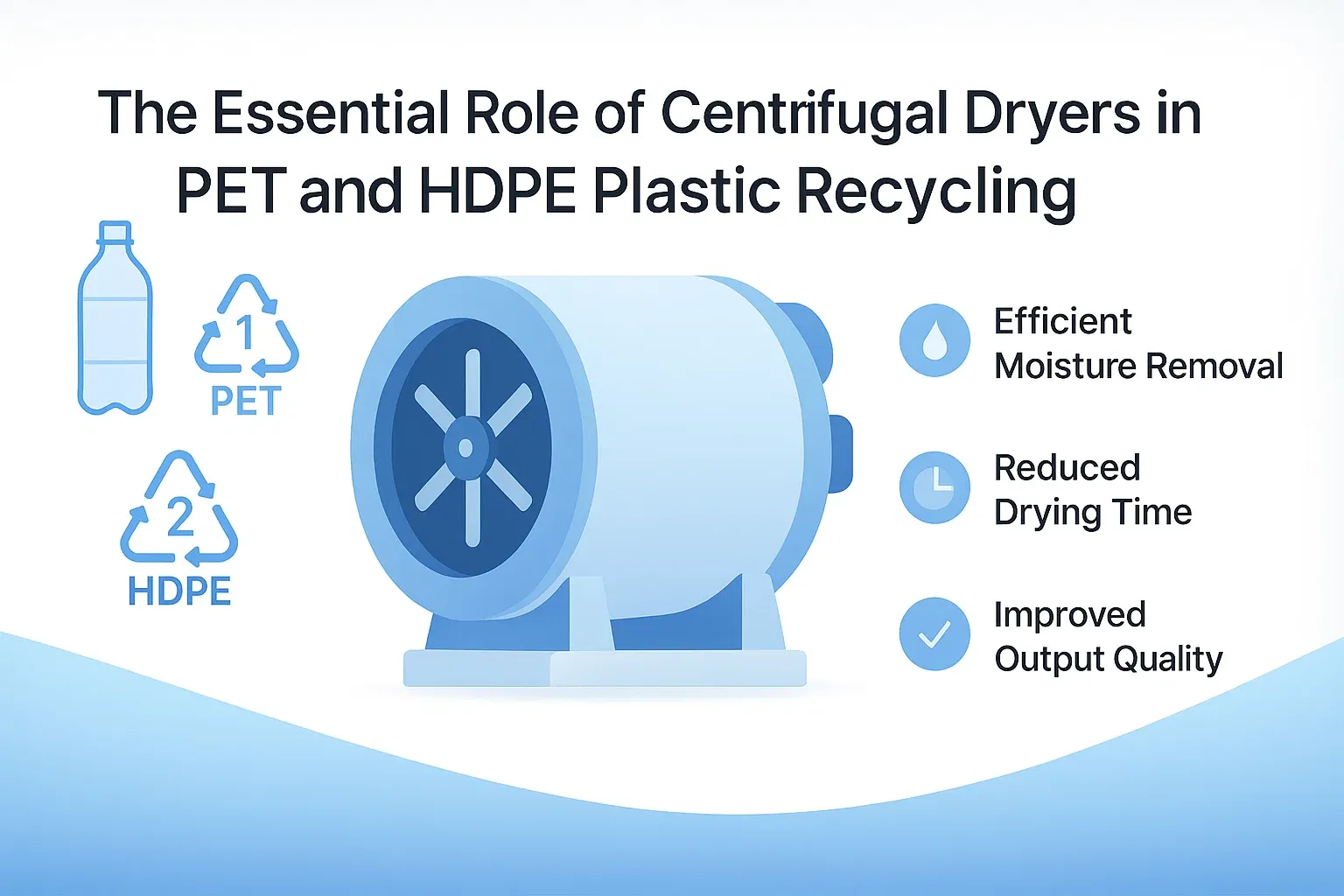Nel mondo del riciclo della plastica, l'umidità rappresenta una sfida costante. L'essiccazione efficiente di materie plastiche come il PET (polietilene tereftalato) e l'HDPE (polietilene ad alta densità) è fondamentale per produrre materiali riciclati di alta qualità pronti per la produzione. Questo è dove il Essiccatore centrifugo entra in gioco come protagonista. Queste macchine innovative sono fondamentali per trasformare scaglie e pellet di plastica bagnati e appena lavati in risorse preziose. Unisciti a noi per scoprire come Essiccatore centrifugo La tecnologia eccelle nel riciclaggio di PET e HDPE, illustrandone i principi di funzionamento e i notevoli vantaggi che apporta al processo.
Capire come funziona un essiccatore centrifugo nel riciclaggio della plastica
Immagina un campione di centrifuga ad alta velocità dedicato all'essiccazione della plastica: è essenzialmente un Essiccatore centrifugo o un macchina disidratatrice per l'essiccazione della plasticaIl processo è elegantemente semplice ma estremamente efficace:
- Alimentazione del materiale: Dopo una fase di lavaggio accurata, vengono introdotti nel contenitore scaglie o pellet di plastica bagnata, comunemente PET o HDPE. Essiccatore centrifugo.
- Rotazione ad alta velocità: All'interno dell'essiccatore, un rotore gira ad alta velocità. Questa rapida rotazione genera una potente forza centrifuga.
- Espulsione dell'acqua: Questa forza agisce sul materiale plastico, proiettando le particelle d'acqua più pesanti verso l'esterno, lontano dalla plastica e verso lo schermo o l'involucro dell'asciugatrice.
- Separazione e dimissione: L'acqua separata viene quindi drenata in modo efficiente, mentre il materiale plastico, ora notevolmente più asciutto, viene scaricato dalla macchina.
- Flusso d'aria opzionale: Per migliorare l'effetto di asciugatura, alcuni Essiccatore centrifugo i modelli possono incorporare un flusso di aria ambiente o riscaldata, riducendo ulteriormente l'umidità residua.
Questo metodo è particolarmente adatto per le forme in scaglie o pellet tipiche del PET e dell'HDPE lavorati. La sinergia tra forza meccanica e flusso d'aria opzionale consente una rimozione completa dell'umidità senza compromettere l'integrità della plastica.
Perché un essiccatore centrifugo è la scelta ideale per il riciclaggio di PET e HDPE
Diverse caratteristiche chiave rendono il Essiccatore centrifugo una soluzione ideale per il riciclaggio delle plastiche PET e HDPE.
1. Efficienza di rimozione dell'umidità senza pari
Le plastiche PET e HDPE, spesso provenienti da articoli come bottiglie per bevande, imballaggi alimentari e contenitori per detersivi, richiedono un contenuto di umidità estremamente basso per una reintegrazione di successo in nuovi prodotti. Essiccatore centrifugo eccelle in questo, capace di ridurre i livelli di umidità a meno di Questa straordinaria efficienza è fondamentale perché un eccesso di umidità può causare imperfezioni come bolle o debolezze strutturali durante i processi di produzione successivi, come lo stampaggio a iniezione o l'estrusione. Raggiungere questo livello di asciugatura garantisce la massima qualità del PET e dell'HDPE riciclati.
2. Preservare la qualità e l'integrità dei materiali
Una delle caratteristiche più importanti di un Essiccatore centrifugo è il suo approccio gentile. Questi essiccatori sfruttano principalmente la forza meccanica anziché il calore aggressivo. Questo è fondamentale per le plastiche sensibili al calore come il PET e l'HDPE, poiché temperature eccessive possono degradarne la struttura fisica e chimica. A differenza di alcune tecniche di essiccazione termica che rischiano di danneggiare la plastica, l'essiccazione centrifuga aiuta il materiale riciclato a mantenere la sua resistenza originale, la sua trasparenza e la sua durevolezza complessiva. Questa attenta gestione è particolarmente vantaggiosa per il PET destinato al riutilizzo in applicazioni a contatto con gli alimenti, dove l'integrità del materiale è fondamentale.
3. Promuovere l'efficienza energetica
In un'epoca in cui il risparmio energetico è fondamentale, Essiccatore centrifugo si distingue. Rispetto a molte tecnologie di essiccazione alternative che dipendono fortemente dall'energia termica, gli essiccatori centrifughi consumano molta meno energia. Il loro affidamento primario su un'efficiente separazione meccanica, anziché su cicli di riscaldamento prolungati, si traduce direttamente in minori costi operativi e una ridotta impronta di carbonio. Questo li rende una scelta economicamente intelligente ed ecologicamente responsabile, soprattutto per gli impianti di riciclaggio che trattano grandi volumi di PET e HDPE.
4. Progettato per operazioni ad alta produttività
Il ritmo del riciclaggio moderno richiede macchinari in grado di tenere il passo. Essiccatore centrifugo I sistemi sono progettati per un funzionamento continuo, elaborando in modo rapido ed efficace notevoli quantità di scaglie o pellet di PET e HDPE. Questa elevata capacità di produzione è essenziale per gli impianti di riciclaggio che mirano a soddisfare la robusta domanda del settore, garantendo un flusso costante di materiale essiccato, riducendo al minimo i colli di bottiglia e massimizzando la produttività complessiva dell'impianto.
5. Minimizzare i rischi di contaminazione
Mantenere la purezza del PET e dell'HDPE riciclati non è negoziabile. Essiccatore centrifugo Le unità contribuiscono in modo significativo a questo risultato operando come sistemi chiusi. Questa progettazione protegge intrinsecamente i materiali plastici da polvere, sporco o altri contaminanti esterni durante la cruciale fase di asciugatura. Il risultato è un prodotto riciclato più pulito e di qualità superiore, preparato e pronto per la sua prossima vita in produzione.
Principali vantaggi dell'utilizzo di un essiccatore centrifugo per il riciclaggio di PET e HDPE
I vantaggi dell'incorporazione di un Essiccatore centrifugo nelle linee di riciclaggio di PET e HDPE si estendono alla qualità del prodotto, ai costi operativi e alla responsabilità ambientale.
Miglioramento della qualità del prodotto finale
L'obiettivo finale del riciclaggio è produrre materiali che siano altrettanto buoni, se non migliori, delle loro controparti vergini. UN Essiccatore centrifugo svolge un ruolo fondamentale nel raggiungimento di questo obiettivo. Rimuovendo meticolosamente l'umidità, si contribuisce a prevenire comuni difetti di fabbricazione, come la formazione di bolle, lo scolorimento o l'aumento della fragilità nei prodotti finali realizzati in PET e HDPE riciclati. Questo impegno per la qualità garantisce che le plastiche riciclate offrano prestazioni eccellenti e un aspetto estetico gradevole, rendendole altamente competitive.
Risparmi significativi sui costi
Investire in un Essiccatore centrifugo è una decisione finanziariamente valida per qualsiasi attività di riciclaggio di PET e HDPE. La loro rinomata efficienza energetica si traduce direttamente in bollette elettriche più basse. Inoltre, queste macchine robuste sono spesso progettate per durare a lungo e richiedono una manutenzione relativamente bassa, riducendo ulteriormente le spese operative a lungo termine. Le prestazioni costanti abbinate a questi risparmi rendono il Essiccatore centrifugo un investimento intelligente che paga dividendi.
Contributi ambientali positivi
Scegliendo un Essiccatore centrifugo, gli impianti di riciclaggio contribuiscono attivamente a un futuro più sostenibile. Il loro ridotto consumo energetico contribuisce a ridurre l'impatto ambientale complessivo del processo di riciclaggio. Ma cosa ancora più importante, consentendo la produzione di PET e HDPE riciclati di alta qualità, questi essiccatori svolgono un ruolo cruciale nell'economia circolare. Ciò riduce la nostra dipendenza dalla produzione di plastica vergine, il che a sua volta preserva preziose risorse naturali e contribuisce ad abbassare le emissioni di gas serra associate alla produzione di nuova plastica.
Diverse applicazioni del PET e dell'HDPE riciclati
Una volta che le plastiche PET e HDPE vengono essiccate in modo esperto utilizzando un Essiccatore centrifugo, vengono trasformati in materie prime preziose, pronte per una moltitudine di nuove applicazioni in vari settori. L'alta qualità di questa plastica riciclata la rende adatta per:
- Confezione: Creazione di nuove bottiglie (per articoli non alimentari o di qualità alimentare, se le normative e i processi lo consentono), contenitori, vaschette e pellicole.
- Costruzione: Produzione di tubi resistenti, pannelli versatili, legname e materiali isolanti efficaci.
- Tessili: Filatura di PET riciclato in fibre di poliestere per abbigliamento, tappeti e altri prodotti tessili.
- Automobilistico: Produzione di vari componenti per automobili, tra cui componenti sotto il cofano ed elementi interni.
- Beni di consumo: Realizzazione di oggetti come giocattoli, mobili robusti e prodotti per la casa di uso quotidiano.
Il ruolo fondamentale del Essiccatore centrifugo nella preparazione di queste plastiche garantisce che possano essere riutilizzate in modo efficace e su larga scala, chiudendo di fatto il cerchio del riciclaggio della plastica.
Conclusione: il ruolo indispensabile dell'essiccatore centrifugo
Nel panorama del riciclo della plastica PET e HDPE, Essiccatore centrifugo è molto più di un semplice pezzo di equipaggiamento: è un pilastro di efficienza, qualità e sostenibilità. La sua ineguagliabile capacità di rimuovere rapidamente e completamente l'umidità, preservando al contempo l'integrità del materiale, garantisce che la plastica riciclata possa soddisfare senza problemi le severe esigenze della produzione moderna.
Per gli impianti di riciclaggio che mirano a migliorare le proprie operazioni, migliorare la qualità del prodotto e ridurre i costi, investire in un sistema ad alte prestazioni Essiccatore centrifugo è una decisione strategicamente valida e finanziariamente vantaggiosa. Queste macchine sono fondamentali per sfruttare appieno il potenziale del PET e dell'HDPE riciclati.
Pronti a ottimizzare il vostro processo di riciclo della plastica? Scoprite di più sui nostri sistemi avanzati Essiccatore centrifugo macchine disidratatrici per l'essiccazione della plastica oppure rivolgiti al nostro team di esperti per una consulenza personalizzata sulla scelta dell'attrezzatura ideale per soddisfare le tue esigenze specifiche.



